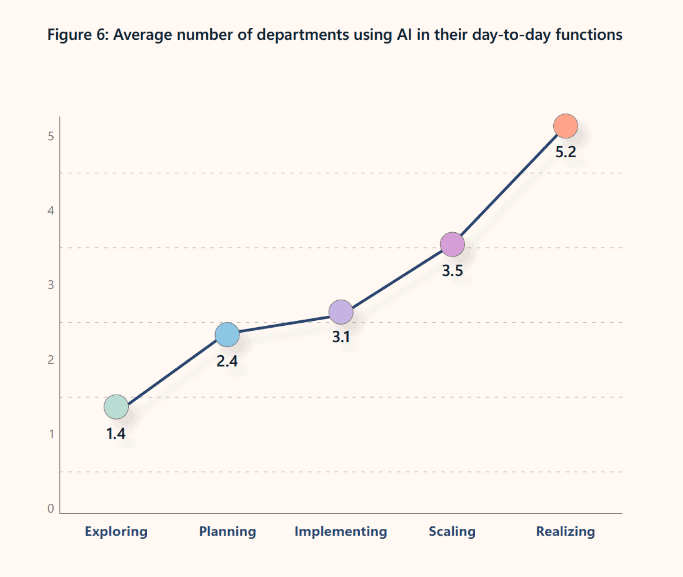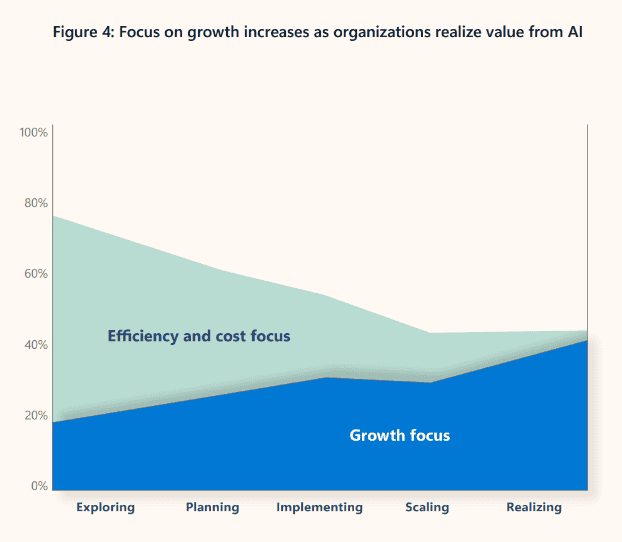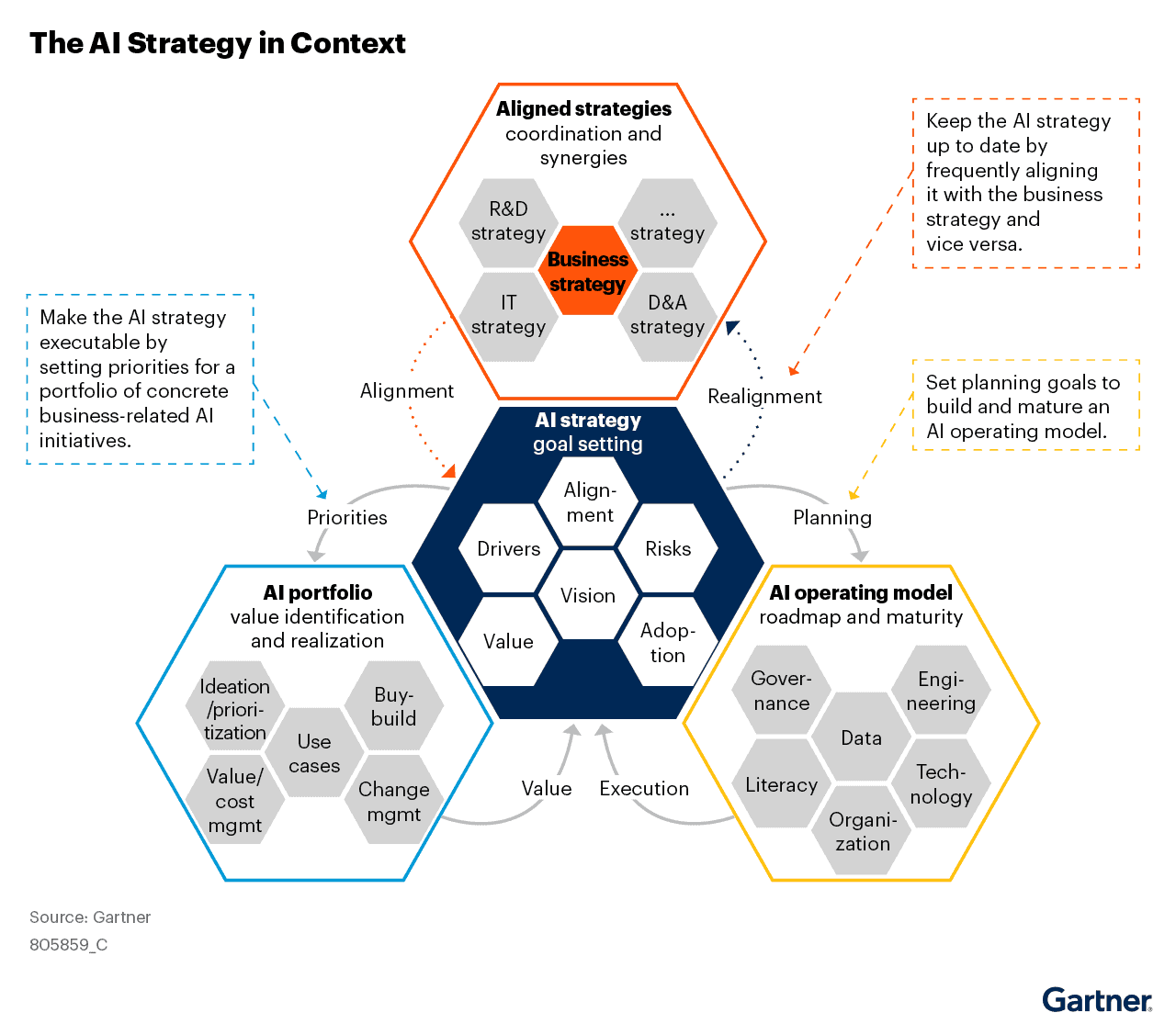AI Strategy Roadmap: Guiding Your Organization Toward Sustainable AI Success
So you want to incorporate artificial intelligence into your business? But where do you even begin? We’ll go over what Microsoft and Gartner define as keys to a successful AI strategy.
Artificial intelligence (AI) is creating efficiencies, insights, and innovation out of the box for businesses around the globe. Yet, most organizations find it difficult to create a programmed AI strategy that best supports their business objectives. Microsoft released an AI Strategy Roadmap to guide companies at different stages of AI readiness through the complexities of AI adoption in order to realize their full potential. We’ll highlight some of the key points of that roadmap while also incorporating key findings from Gartner’s The Pillars of a Successful Artificial Intelligence Strategy.
Before entering the roadmap, one ought to be aware of the main driving factors of AI readiness within an organization. These drivers are dependent on business strategy, technology and data infrastructure, experience with AI, organizational culture, and governance. They collectively determine a company’s ability to implement AI solutions effectively and scale them to drive tangible business value.
The first crucial aspect is aligning AI initiatives with the broader business strategy. AI projects must contribute directly to achieving strategic goals, whether through efficiency gains, revenue generation, or innovation. To achieve this alignment, organizations need to carefully select and prioritize AI use cases, establish clear success metrics, and ensure that the initiatives are integrated into the overall business strategy.
Equally important is the business’ technology and data strategy. Access to high-quality data and a robust technological infrastructure is foundational to success. Organizations must ensure they have the necessary data, cloud infrastructure, and analytics capabilities to support AI at scale. Without the right data and technological backbone, even the most well-conceived AI strategies will struggle to deliver value.
Next, a clear understanding of AI technologies and the experience to implement them are critical. This includes developing repeatable processes for development and deployment and building expertise across various AI domains, such as machine learning, neural networks, and generative AI. The ability to apply these technologies effectively, coupled with the experience to scale them, is what separates organizations that merely experiment with AI from those that achieve sustained business impact.

Image courtesy of Microsoft
Organizational culture also plays a pivotal role in AI readiness. Leadership vision, organizational structure, and a culture that supports innovation are key enablers of success. Companies must foster a culture of agility, experimentation, and continuous learning to fully leverage AI’s potential. This cultural shift is often driven by senior leaders who clearly communicate the importance of AI and provide the necessary resources and support to drive these initiatives forward.
Finally, AI governance is essential for ensuring the responsible use of AI. As businesses scale their efforts, establishing robust processes and controls becomes increasingly important to manage data privacy, security, and ethical considerations. Effective governance helps build trust with stakeholders and mitigates risks associated with deployment, making it a critical component of any AI strategy.
The AI Strategy Roadmap: A Stage-Based Approach
The AI Strategy Roadmap is structured around five stages of AI readiness: Exploring, Planning, Implementing, Scaling, and Realizing. Each stage represents a different level of maturity in AI adoption and comes with specific priorities and actions that organizations should focus on.
Exploring: At the initial stage, organizations are just beginning their AI journey, often experimenting with AI in select areas of the business. The focus here is on gaining knowledge and experience with models, building diverse teams with a mix of business and technical expertise, and developing repeatable processes for AI development. During this stage, companies should concentrate on identifying initial use cases that align with their strategic objectives and establishing a basic data infrastructure to support these experiments.
Planning: As businesses move to the planning stage, they begin to define their AI strategy more formally and plan for broader deployments. This stage involves moving from experimentation to formalizing AI initiatives. Developing a business strategy that clearly outlines goals, prioritizing use cases based on potential impact and feasibility, and building out the necessary technology and data infrastructure are key activities. Leadership commitment becomes critical at this stage, as securing the necessary resources and funding depends heavily on top management’s support.
Implementing: In the implementation stage, organizations start transitioning from proofs of concept to full-scale AI deployments. This phase focuses on turning AI strategies into operational realities. Strong leadership support is crucial, along with clear communication about AI’s value to the org. Implementing these solutions requires not only technological readiness but also a strong organizational culture that embraces change. Continuous monitoring and refinement of AI models based on real-world data and outcomes are essential to ensure a success of these implementations.

Image courtesy of Microsoft
Scaling: Scaling AI involves expanding deployments across the company to drive greater value. At this stage, organizations focus on optimizing their AI infrastructure and processes to support large-scale initiatives. A comprehensive investment plan for AI becomes increasingly important, as does standardizing processes to ensure consistency and efficiency. As AI is more deeply integrated into business workflows, monitoring and optimizing these solutions for performance and scalability are crucial to sustainability.
Realizing: In the final stage, businesses begin to see constant, measurable value from their AI initiatives. The focus shifts to maximizing return on investment (ROI) from AI and ensuring that AI-driven growth is maintained. Regular alignment of AI with evolving business goals is necessary to keep up momentum and adapt to changing market conditions. Expanding AI expertise throughout the organization, strengthening governance frameworks to address new challenges, and investing in advanced AI capabilities are key to staying ahead in this dynamic field.
Best Practices for AI Strategy Success
To ensure a positive outcome of your AI strategy, there are several best practices that organizations should consider. First and foremost is securing leadership commitment. Senior leaders play a critical role in driving these initiatives, and their support is essential for securing the resources and creating the cultural shift necessary for AI adoption. Clear communication from leadership about the importance of AI can help build a shared vision and foster alignment across the organization.
Another vital practice is focusing on value creation. It’s important for companies to prioritize AI projects that are closely aligned with their strategic objectives and have the potential to deliver significant value. Rather than getting caught up in the hype surrounding AI, businesses should concentrate on use cases that address real challenges and opportunities within their operations. This approach helps ensure that AI investments yield tangible benefits and contribute to long-term value.
Investing in talent and training is also crucial. Organizations must build teams that combine AI expertise with deep business knowledge. Providing ongoing training and development opportunities is key to keeping skills current and fostering innovation. Additionally, creating a culture of experimentation is key for businesses to stay competitive. By encouraging experimentation and learning from failures, companies can develop a more agile approach to AI that allows them to quickly adapt to new challenges and opportunities.
Finally, implementing strong governance frameworks is essential for managing the risks associated with AI. This includes establishing clear guidelines for data privacy, security, and ethical considerations. Effective AI governance not only helps mitigate risks but also builds trust with customers, employees, and other stakeholders. As AI continues to evolve, maintaining robust governance practices will be critical to ensuring the responsible use of AI technologies.

An effective AI strategy roadmap is paramount to navigating the maze of complexities entailed in AI adoption and realizing its potential in full measure. Once organizations are aware of the stages of AI readiness, and with a focus on key drivers of success, they can build an articulated way for AI which supports their business goals and sustains value. No matter if your business is at the starting line of their AI journey or already in the process of scaling initiatives, this is a blueprint that will help your company realize your AI aspirations through innovation across your entire business.
Ready to start or scale your AI program? Contact us to learn about our extensive services!
Looking for more on AI?
Explore more insights and expertise at smartbridge.com/ai
There’s more to explore at Smartbridge.com!
Sign up to be notified when we publish articles, news, videos and more!
Other ways to
follow us:




